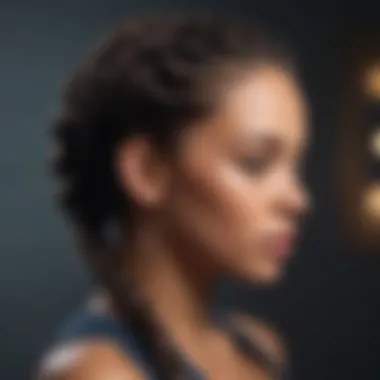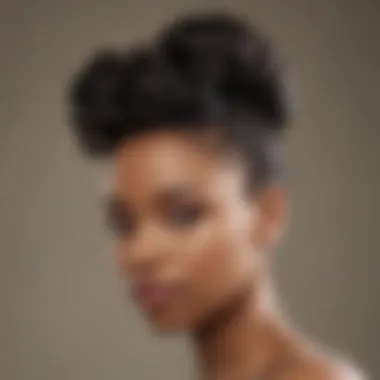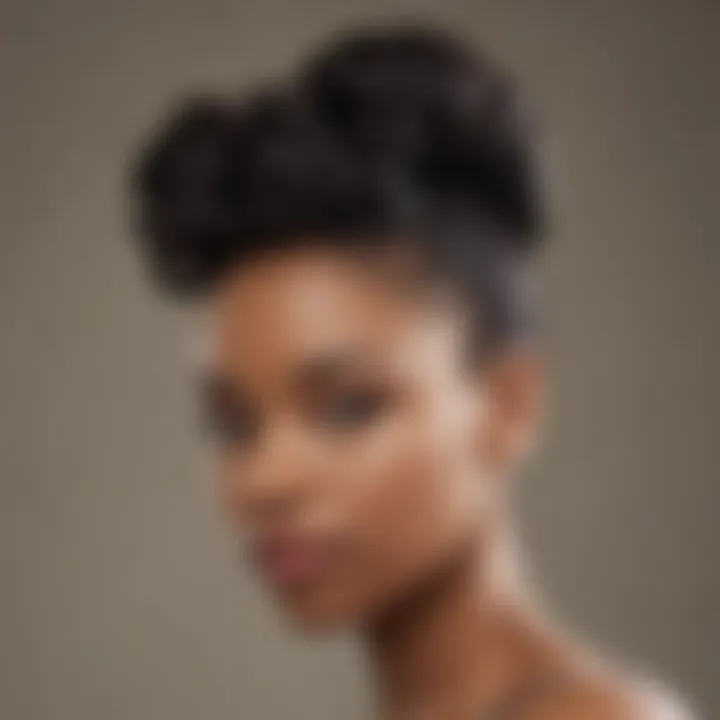Unlock the Beauty of Natural Hair with Protective Hairstyles for Maximum Health and Vitality


Fashion Trends & Style Guides
Beauty & Wellness
When it comes to natural hair, maintaining its health and vitality is essential. Protective hairstyles play a pivotal role in this journey, not only shielding the hair from external damage but also aiding in its growth and strength. From intricate twists that protect the strands to chic loc styles that exude elegance, each protective hairstyle is a testament to the fusion of beauty and wellness. By delving into the world of protective hairstyles on natural hair, one uncovers not just a fashion statement but a holistic approach to hair care that promotes radiance and strength.
Pop Culture & Entertainment
Celebrity endorsements and media influence have contributed significantly to the popularity of protective hairstyles on natural hair. From red carpet events to music videos, these styles have become synonymous with glamour and sophistication. As celebrities sport diverse protective hairstyles, they not only set trends but also inspire individuals to experiment with their own natural hair. Exploring the cultural impact of protective hairstyles delves deep into the intersection of beauty, entertainment, and self-expression, shaping a narrative that goes beyond aesthetics to encompass empowerment and identity.
Introduction to Protective Hairstyles
Protective hairstyles for natural hair have seen a surge in popularity due to their ability to safeguard hair from damage and enhance its overall health. These styles serve as a protective shield, minimizing the exposure of hair strands to harsh environmental elements and excessive manipulation during styling routines. The essence of protective hairstyles lies in their functionality to promote hair growth, reduce breakage, and offer a myriad of versatile styling options. By opting for protective hairstyles, individuals can not only maintain the integrity of their natural hair but also foster a sense of individuality and creativity in their overall look.
Understanding the Concept of Protective Hairstyles
Definition and Purpose of Protective Hairstyles
The definition and purpose of protective hairstyles revolve around their primary function of safeguarding the natural hair's health and integrity. These styles involve creating low-manipulation or low-tension looks that shield the hair from stress and breakage, encouraging length retention and overall hair health. Embracing protective hairstyles aids in minimizing exposure to damaging practices such as heat styling, combing, and environmental factors, thereby nurturing the hair from root to tip. The characteristic feature of protective hairstyles lies in their ability to preserve the natural texture of hair while promoting its growth and vitality.
Historical Significance of Protective Styles
The historical significance of protective styles traces back to centuries-old traditions where various cultures utilized braids, twists, and intricate updos to protect their hair from environmental elements and signify cultural identity. From ancient civilizations to modern-day fashion trends, protective styles have transcended time, symbolizing resilience, beauty, and heritage. The enduring appeal of protective hairstyles lies in their timeless elegance and practicality, serving as more than just a trend but a symbol of strength and sophistication.
Benefits of Protective Hairstyles
Promotes Hair Growth
One of the key advantages of protective hairstyles is their ability to promote hair growth by minimizing manipulation and reducing breakage. These styles create a conducive environment for hair to thrive, allowing individuals to retain length and achieve their desired hair goals effectively. By opting for protective styles that prioritize hair health, individuals can experience noticeable improvements in texture, strength, and overall growth, fostering a flourishing mane.
Reduces Breakage and Damage
Protective hairstyles play a vital role in reducing breakage and damage by minimizing exposure to external stressors and harmful practices. The low-tension nature of these styles ensures that hair is not subjected to undue strain or tension, thereby decreasing the likelihood of breakage and split ends. Embracing protective hairstyles encourages healthier hair habits and fosters a nurturing environment for natural hair to flourish.
Versatile Styling Options


In addition to their protective benefits, these hairstyles offer a plethora of versatile styling options that cater to various preferences and occasions. Whether opting for intricate braided styles, elegant updos, or chic twists, individuals can experiment with different looks while safeguarding their hair's health. The versatility of protective hairstyles enables individuals to express their creativity and personal style through an array of fashion-forward choices, ensuring that protection and style go hand in hand.
Twist Hairstyles
When it comes to protective styling, twist hairstyles offer a charming and protective alternative for natural hair. These styles help in retaining moisture, reducing breakage, and nurturing the hair's overall health. Some popular twist hairstyles include:
Havana Twists
Havana twists are bulky and smooth twists that exude an effortless and chic vibe. They are great for protecting the hair from manipulation and external damage while retaining moisture and promoting growth. Havana twists are favored for their ability to blend well with natural hair and their longevity.
Senegalese Twists
Senegalese twists are sleek and slender twists that provide a polished and sophisticated look. These twists are known for their lightweight feel and versatility in styling. Senegalese twists offer a protective shield for the hair, allowing for continuous growth and minimal breakage.
Two-Strand Twists
Two-strand twists are a simple yet effective protective style for natural hair. They involve twisting two sections of hair around each other to create a defined and textured look. Two-strand twists are popular for their ease of installation and maintenance, making them an ideal choice for individuals seeking a versatile and timeless hairstyle.
Protective Updos
Protective updos are an elegant and practical way to safeguard natural hair while maintaining a sophisticated appearance. These styles are versatile and easy to maintain, providing both protection and style. Popular options for protective updos include:
Bantu Knots
Bantu knots are small, coiled sections of hair that are twisted and wrapped to form intricate knot-like structures. They are favored for their ability to protect the hair's ends and retain moisture. Bantu knots offer a fun and creative styling option while promoting healthy hair growth and length retention.
Goddess Braids Updo
Goddess braids updo is a regal and stylish hairstyle that involves braiding the hair into large, intricate plaits. This updo offers a protective and glamorous look, perfect for special occasions or everyday wear. Goddess braids updo is preferred for its longevity and ability to keep the hair secure and stylish.
Pineapple Updo
The pineapple updo is a quick and easy protective style that involves gathering the hair at the top of the head in a loose, high ponytail. This style is great for maintaining curl definition and protecting the hair while sleeping. The pineapple updo is popular for its simplicity and effectiveness in preserving hairstyles and reducing tangles.
Tips for Caring for Natural Hair in Protective Styles
Caring for natural hair while using protective styles is crucial for maintaining its health and vitality. This section will delve into essential tips and practices for enhancing the well-being of your hair while it's in a protective style. Proper care not only ensures the longevity of the style but also promotes overall hair health, preventing issues like breakage and dryness.


Moisture Retention
Using Hydrating Products
Utilizing hydrating products is a cornerstone of preserving moisture in natural hair, especially when styled protectively. These products contain nourishing ingredients that help in hydrating the hair shaft and locking in moisture. They play a vital role in preventing dryness and brittleness, contributing to the overall health of your hair. While some products may contain chemicals, opting for natural, organic options can offer a more gentle and nourishing experience for your hair. Ensuring your hair is adequately moisturized can lead to improved manageability, elasticity, and shine.
Sealing Moisture with Oils
Sealing moisture with oils is another essential step in maintaining well-hydrated hair. Oils act as a barrier, helping to retain the moisture within the hair strands and prevent environmental factors from stripping it away. Natural oils like coconut, argan, and jojoba oil are popular choices due to their ability to nourish and protect the hair without weighing it down. Sealing the hair with oils after moisturizing can enhance the health and appearance of your hair, leaving it soft, shiny, and less prone to breakage.
Scalp Care
Proper scalp care is fundamental for the health of your hair, especially when sporting protective styles. Maintaining a clean and healthy scalp contributes to optimal hair growth and prevents issues like dandruff and irritation. By keeping your scalp free from product buildup and impurities, you create a conducive environment for hair follicles to thrive.
Keeping Scalp Clean and Healthy
Regularly cleansing your scalp is essential to remove dirt, excess oil, and buildup that can hinder hair growth and cause scalp issues. Using a gentle shampoo that effectively cleanses without stripping away natural oils is key to promoting scalp health. A clean scalp not only supports hair growth but also ensures that your protective style remains fresh and odor-free.
Massaging Scalp Regularly
Massaging your scalp on a regular basis can stimulate blood flow to the hair follicles, promoting healthy hair growth. This simple technique not only feels relaxing but also helps in distributing natural oils from the scalp to the hair strands, keeping them moisturized and nourished. Regular scalp massages can also alleviate tension and improve the overall health and appearance of your hair.
Protective Styling Practices
Adopting the right styling practices is essential for maximizing the benefits of protective hairstyles. By being mindful of how you style your hair, you can minimize damage and maintain the integrity of your hair while it's in a protective state.
Avoiding Tight Styles
Avoiding tight styles is crucial to prevent unnecessary tension on the hair shaft, which can lead to breakage and hair loss. Opting for looser styles reduces the risk of traction alopecia and discomfort associated with tight braids or twists. Prioritizing the health of your hair over tightly styled aesthetics is key to preserving the strength and elasticity of your natural hair.
Limiting Heat Styling
Minimizing heat styling when sporting protective hairstyles can prevent heat damage and dryness. Excessive use of flat irons or curling wands can weaken the hair cuticle and lead to dull, brittle strands. Embracing heat-free styling methods like bantu knots or roller sets can help in maintaining the integrity of your hair while allowing it to thrive and grow. By reducing heat exposure, you protect your hair from harm and promote its overall health and vitality.
Maintaining Protective Styles


Maintaining protective styles is a crucial aspect covered in this comprehensive article on exploring protective hairstyles for natural hair. It is essential to understand the significance of proper maintenance in preserving the health and vitality of natural hair. By following specific elements and best practices for maintaining protective styles, individuals can prolong the lifespan of their chosen hairstyle while promoting overall hair health and appearance. This section delves into the benefits and considerations of maintaining protective styles, emphasizing the importance of a well-rounded care routine to ensure long-lasting and stunning results.
Nighttime Care Routine
Using Satin or Silk Bonnet
The utilization of a satin or silk bonnet holds paramount importance in the realm of maintaining protective styles for natural hair. This key aspect aids in protecting the hair during sleep, preventing friction and frizz that can compromise the integrity of the hairstyle. The notable feature of using a satin or silk bonnet lies in its ability to preserve moisture and reduce breakage, contributing to the overall health and longevity of the hair. While discussing this topic, it is crucial to highlight the unique characteristic of these bonnets and why they are a preferred choice for individuals embracing protective hairstyles. Moreover, detailing the advantages and possible drawbacks of using satin or silk bonnets solidifies their place in this article, accentuating their significance in maintaining hair health.
Protecting Hairline with Scarf
Another vital component of the nighttime care routine is protecting the hairline with a scarf. This practice plays a pivotal role in safeguarding the delicate edges of natural hair, preventing any undue stress or damage while sleeping. The key characteristic of using a scarf to protect the hairline revolves around maintaining the integrity of the hairline, ensuring that no tension or friction disrupts the growth pattern. By exploring the unique features of this method, such as its simplicity and effectiveness, readers can grasp its benefits and understand why it is a popular choice in the realm of protective hairstyling. Discussing the advantages and potential disadvantages of this practice within the context of this article sheds light on its importance in maintaining the overall health and aesthetics of natural hair.
Washing and Refreshing
Cleansing Scalp and Hair Gently
An essential aspect of hair care in protective styles is cleansing the scalp and hair gently. This practice helps in removing buildup and maintaining scalp health without compromising the protective hairstyle. Emphasizing the gentle nature of this cleansing method and its benefits paves the way for healthier hair and a refreshed scalp. Furthermore, delineating the unique features of gentle cleansing and exploring its advantages and any associated disadvantages within the scope of this article presents a clear picture of its role in maintaining protective styles.
Refreshing Hairstyle
Refreshing the hairstyle is a crucial step in the maintenance of protective styles, ensuring that the hair remains pristine and styled appropriately. This process revitalizes the appearance of the hairstyle, extending its longevity and vibrancy. By highlighting the key characteristic of refreshing hairstyles and elucidating why it is a popular and beneficial choice for individuals sporting protective styles, readers can appreciate the importance of this practice. Exploring the unique features of refreshing the hairstyle and discussing its advantages and any possible downsides in the context of this article enhances understanding and emphasizes its significance in styling maintenance.
Styling Maintenance
Retouching Edges
An integral part of maintaining protective hairstyles is retouching the edges to keep the overall look polished and neat. This practice involves redefining the hairline and edges to maintain a clean and well-groomed appearance. The key characteristic of retouching edges lies in its ability to enhance the overall hairstyle and elevate the wearer's aesthetic. Understanding why this practice is beneficial and popular in the context of this article provides clarity on its role in styling maintenance. Describing the unique features of retouching edges and evaluating its advantages and potential drawbacks within the framework of this article underscores its importance in maintaining the desired look of protective hairstyles.
Re-braiding or Re-twisting
In the realm of styling maintenance for protective hairstyles, the practice of re-braiding or re-twisting is instrumental in upkeeping the chosen hairstyle's integrity and form. This process involves redoing the braids or twists to refresh the hairstyle and ensure it retains its original allure. The key characteristic of re-braiding or re-twisting is its transformative effect on the hairstyle, offering a fresh and polished appearance. Discussing why individuals opt for this method and its popularity and benefits within the context of this article sheds light on its significance in styling maintenance. Exploring the unique features of re-braiding or re-twisting and examining its advantages and potential drawbacks in the context of this article solidifies its role in maintaining the desired look and quality of protective hairstyles.
Conclusion
Embracing Protective Styles for Natural Hair
Empowering Hair Journey
The concept of an empowering hair journey within the context of protective styling on natural hair emerges as a pivotal aspect of self-expression and self-care. Through the lens of embracing protective styles, the empowering hair journey symbolizes a personal evolution towards embracing one's natural hair texture and celebrating its unique beauty. This journey involves a transition from conventional styling norms to a more authentic and empowering approach, fostering confidence and individuality. The empowering hair journey encourages individuals to break free from societal standards, embracing their natural hair with pride and conviction.
Nurturing Natural Beauty
Nurturing natural beauty within the realm of protective hairstyles for natural hair emphasizes the profound transformative impact these styles can have on one's overall aesthetic. By nurturing natural beauty through protective styles, individuals not only protect their hair from external damage but also enhance its intrinsic beauty and allure. This approach underscores the importance of self-care and resilience, as individuals actively engage in practices that promote the health and radiance of their natural hair. Nurturing natural beauty through protective hairstyles embodies a conscious effort to prioritize wellness and authenticity, cultivating a strong sense of self-esteem and appreciation for one's unique features.







